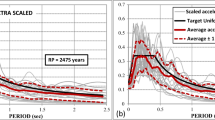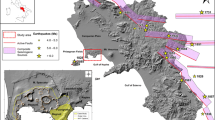Abstract
The problem of accounting for local soil effect on earthquake ground motion is especially urgent when assessing seismic hazard — recent needs of earthquake engineering require local site effects to be included into hazard maps. However, most recent works do not consider the variety of soil conditions or are performed for generalized site categories, such as “hard rock,” “soft soil” or “alluvium.” A technique of seismic hazard calculations on the basis of the Fourier Amplitude Spectra recently developed by the authors allows us to create hazard maps involving the influence of local soil conditions using soil/bedrock spectral ratios. Probabilistic microzoning maps may be constructed showing macroseismic intensity, peak ground acceleration, response and design spectra for various return periods (probability of exceedance), that allow optimization of engineering decisions. An application of this approach is presented which focused on the probabilistic microzoning of the Tashkent City.
Access this chapter
Tax calculation will be finalised at checkout
Purchases are for personal use only
Preview
Unable to display preview. Download preview PDF.
Similar content being viewed by others
References
Bazzuro, P. and Cornell, C. A. (1999), Disaggregation of Seismic Hazard, Bull. Seismol. Soc. Am. 89, 501–520.
Bernreuter, D. L., Chen, J. C. and Savy, J. B. (1986), A methodology to correct for the effect of the local site’s characteristics in seismic hazard analyses. In Proc. 3 U.S. National Conf. Earthquake Engineering (Charleston, California, August 24–28, 1986, v. 1, El Cerrito, California), pp. 245–255.
Boore, D. M. (1983), Stochastic Simulation of High frequency Ground Motions, Based on Seismological Model of the Radiated Spectra, Bull. Seismol. Soc. Am. 73, 1865–1894.
Borchfrdt, R. D. (1994), Estimates of Site-dependent Response Spectra for Design (Methodology and Justification), Earthquake Spectra 10(4), 617–653.
Cao, T., Petersen, M. D., Cramer, C. H., Toppozada, T. R., Reichle, M. S. and Davis, J. F. (1999), The Calculation of Expected Loss Using Probabilistic Seismic Hazard, Bull. Seismol. Soc. Am. 89, 867–876.
Chapman, M. C. (1995), A Probabilistic Approach to Ground-motion Selection for Engineering Design, Bull. Seismol. Soc. Am. 85, 937–942.
Chernov, Yu. K., Strong Ground Motion and Quantitative Assessment of Seismic Hazard, (Tashkent, Fan Publishing House 1989) (in Russian).
Chernov, Yu. K. and Soxolov, V. Yu. (1999), Correlation of Seismic Intensity with Fourier Acceleration Spectra, Phys. Chem. Earth (A) 24 (6), 523–528.
Cornell, C. A. (1968), Engineering Seismic Risk Analysis, Bull. Seismol. Soc. Am. 58, 1583–1606.
Corsanego, A., Recent trends in the field of earthquake damage interpretation. In Proc. 10th European Conf. Earthquake Engineering (Balkema, Rotterdam 1995), pp. 763–771.
Costa, G., Panza, G. F., Suhadolc, P. and Vaccari, F. (1993), Zoning of the Italian Territory in Terms of Expected Peak Ground Acceleration Derived from Complete Synthetic Seismograms, J. Appl. Geophys. 30, 149–160.
Cramer, C. H. and Petersen, M. D. (1996), Predominant Seismic Source Distance and Magnitude Maps for Los Angeles, Orange, and Ventura Counties, California, Bull. Seismol. Soc. Am. 86, 1645–1649.
Erdik, M., Developments on empirical assessment of the effect of surface geology on strong ground motion. In Proc. 10th European Conf. on Earthquake Engineering (Balkema, Rotterdam 1995), pp. 2593–2598.
Harmsen, S., Perkins, D. and Frankel, A. (1999), Deaggregation of Probabilistic Ground Motions in the Central and Eastern United States, Bull. Seismol. Soc. Am. 89, 1–13.
HAZUS (1997), Earthquake Loss Estimation Methodology. Technical manual.
Huo, J.-R. and Hu, Y., Magnitude and distance dependent envelope function of acceleration time history. In Proc. Fifth U.S. National Conf. Earthquake Engineering, (Chicago, July 10–14, III, 1994), pp. 168–178.
Jacob, K. H., Seismic zonation and site response: Are building-code soil factors adequate to account for variability of site conditions across the US?. In Proc. Fourth Int. Conf. Seismic Zonation (Stanford, California 1991), pp. 695–702.
Krawinkler, H., New trends in seismic design methodology. In Proc. 10th European Conf. Earthquake Engineering (Balkema, Rotterdam 1995), pp. 821–830.
Martini, G., Romeo, R., Sabetta, F., Soddi, P., Daminelli, R., Marcellini, A., Mirenna, S., Pagani, M., Riva., F. and Manelli, G., SMCP — Seismic Microzoning Computer Program. In Proc. XXIV General Assembly of ESC, (September 19–24, Athens, Greece, III, University of Athens, Greece 1994), pp. 1619–1627.
Mcguire, R. K. (1995), Probabilistic Seismic Hazard Analysis and Design Earthquakes: Closing the Loop, Bull. Seismol. Soc. Am. 85, 1275–1284.
Newmark, N. M. and Hall, W. J., Procedures and criteria for earthquake resistant design: Building practices for disaster mitigation. In Building Science Services,46(1), (National Bureau of Standards 1973), pp. 209–237.
Orozova, I. M. and Suhadolc, P. (1999), A Deterministic-probabilistic Approach for Seismic Hazard Assessment, Tectonophysics 312, 191–202.
Paz, M. (ed.), International Handbook of Earthquake Engineering. Codes,Programs, and Examples (Chapman and Hall, New York 1994).
Petersen M. D., Bryant, W. A., Cramer, C. H., Reichle, M. S. and Real, C. R. (1997), Seismic Ground-motion Hazard Mapping Incorporating Site Effects for Los Angeles, Orange, and Ventura Counties, California: A Geographical Information System Application, Bull. Seismol. Soc. Am. 87, 249–255.
Shapira, A. and Van Eck, T. (1993), Synthethic Uniform-hazard Site-speck Response Spectrum, Natural Hazards 8, 201–215.
Schenk, V., Schenkova, Z. and Kottnauer, P., Earthquake hazard correction for effect of near-surface sediments: An example of the Bilina District, Czech Republic. In Proc. XXIV General Assembly of ESC (September 19–24, Athens, Greece, III, University of Athens, Greece 1994), pp. 1435–1436.
Shteinberg, V. V. (1983), On the Earthquake Source Parameters and Seismic Effect during the Earthquakes, Izvestiya, Phys. Solid Earth 7, 49–64 (in Russian).
Shteinberg, V. V., Ground motion parameters during strong earthquakes. In Detailed Engineering-Seismological Research (Engineering Seismology Problems, iss. 27). (Moscow, Nauka Publishing House 1986) (in Russian).
Sokolov, V. Yu. and Chernov, Yu. K. (1998), On the Correlation of Seismic Intensity with Fourier Amplitide Spectra, Earthquake Spectra 14(4), 679–694.
Somerville, P., Ground-motion attenuation relationships and their application to aseismic design and seismic zonation. In Proc. Second Int. Symp. Effects of Surface Geology on Seismic Motion, (Balkema, Rotterdam 1998), pp. 35–49.
Spence, R., Coburn, A. and Pomonis, A., Correlation of ground motion with building damage: The definition of a new damage-based seismic intensity scale. In Proc. Tenth World Conf. Earthq. Eng. (Madrid, vol. 1, 1998), pp. 551–556.
Suzuxu, S. and Kiremidjan, A. S., Consideration of soil parameters uncertainties in the time-dependent seismic hazard models. In Struct. and Stochast. Methods (Developments in Geotechnical Engineering), 45 (Amsterdam 1988), pp. 427–438.
Toki, K., Sato, T. and Kiyono, J. (1991), Estimation of peak acceleration for seismic microzonation taking into account the fault extent. In Proc. Fourth Int. Conf. Seismic Zonation (Stanford, California 1991), pp. 731–738.
Trifunac, M. D. (1990), A Microzonation Method Based on Uniform Risk Spectra, Soil Dyn. Earthq. Engin. 9, 34–43.
Trifunac, M. D. and Novikova, E. I., State of art review on strong motion duration. In Proc. 10th European Conf. Earthquake Engineering (Balkema, Rotterdam 1995), pp. 131–140.
Wald, D. J., Qurroriano, V., Heaton, T. H. and Kanamori, H. (1999), Relationships between Peak-ground Acceleration, Peak-ground Velocity and Modified Mercalli Intensity in California, EarthquakeSpectra (in press).
Youngsoungs, R. R., Abrahamson, N., Makdisi, F. I. and Sadigh, K. (1995), Magnitude-dependent Variance of Peak-ground Acceleration,Bull. Seismol. Soc. Am. 85, 1161–1176. (Received August 17,1998, reviewed/accepted February 24, 2000)
Author information
Authors and Affiliations
Editor information
Editors and Affiliations
Rights and permissions
Copyright information
© 2002 Springer Basel AG
About this chapter
Cite this chapter
Sokolov, V.Y., Chernov, Y.K. (2002). Probabilistic Microzonation of Urban Territories: A Case of Tashkent City. In: Roca, A., Oliveira, C. (eds) Earthquake Microzoning. Pageoph Topical Volumes. Birkhäuser, Basel. https://doi.org/10.1007/978-3-0348-8177-7_2
Download citation
DOI: https://doi.org/10.1007/978-3-0348-8177-7_2
Publisher Name: Birkhäuser, Basel
Print ISBN: 978-3-7643-6652-0
Online ISBN: 978-3-0348-8177-7
eBook Packages: Springer Book Archive




